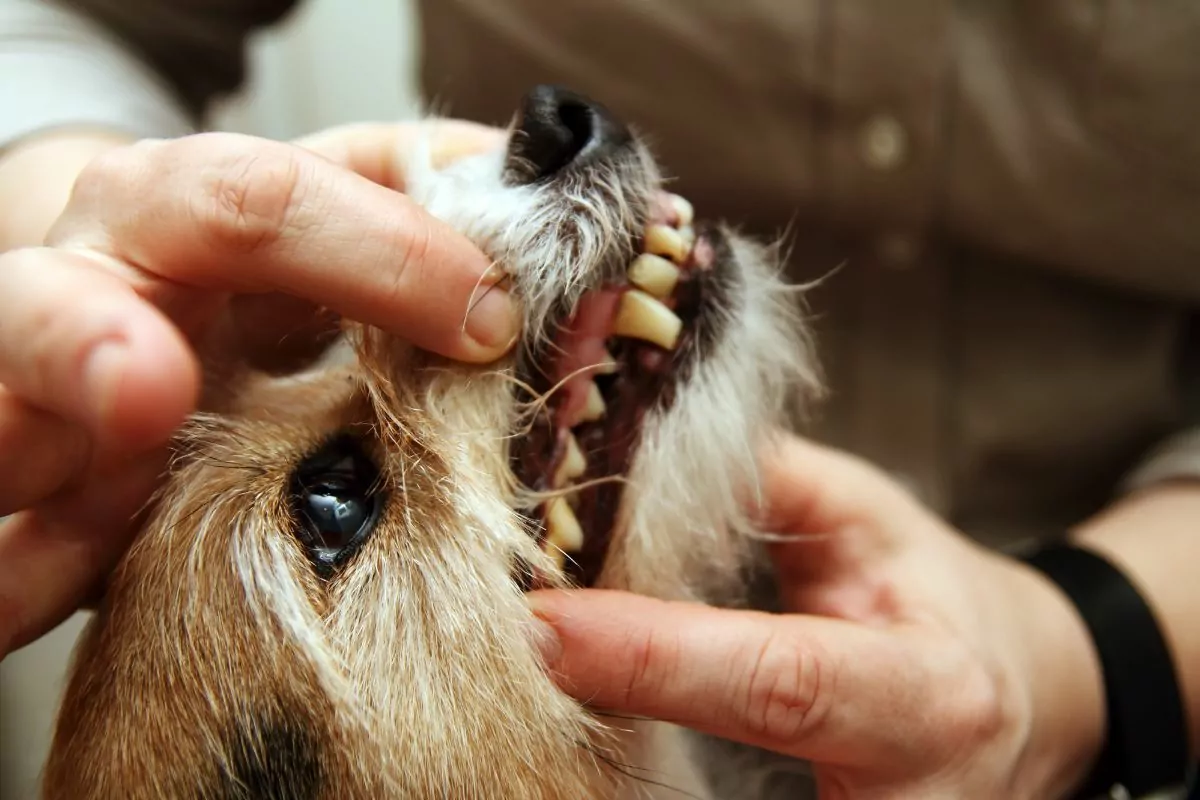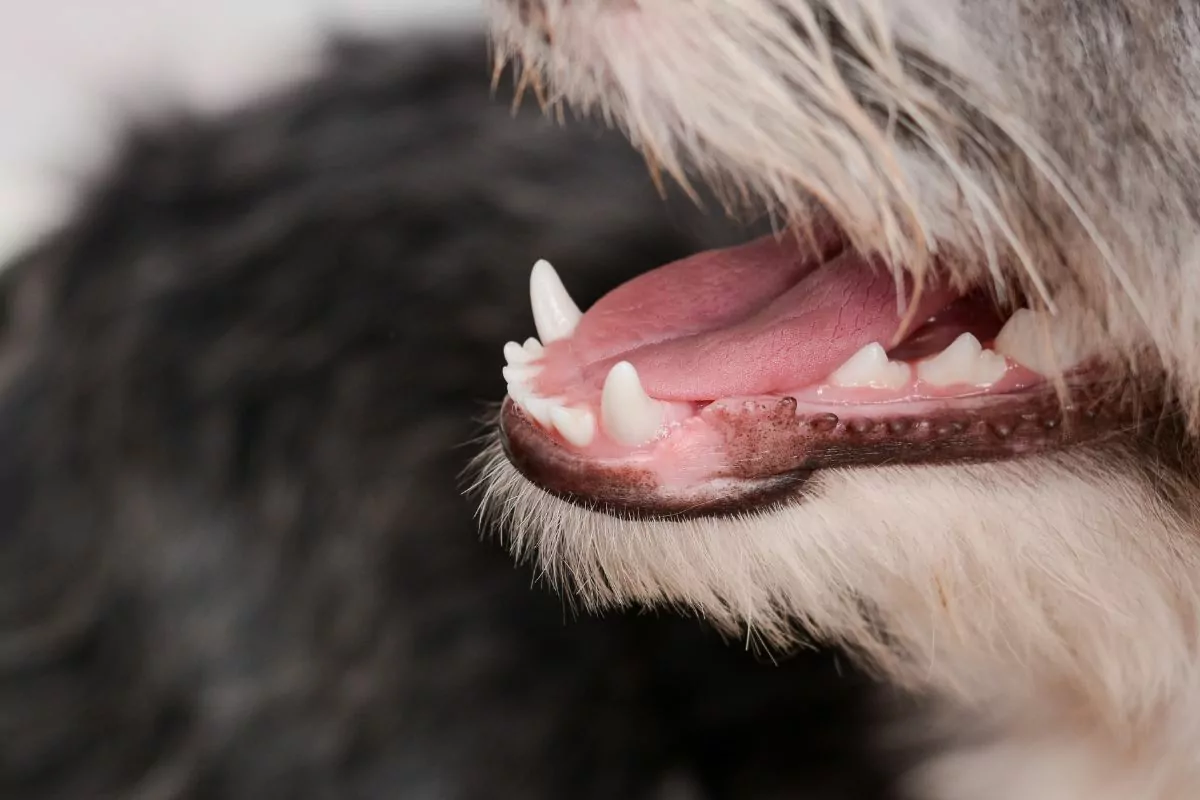How Many Teeth Does a Dog Have?
Puppies have 28 deciduous teeth, while adult dogs have 42. Due to the prevalence of dog tooth problems, dental care is an essential component of dog ownership. Many dental problems in dogs are similar to those in humans.
Dental care, including preventive measures such as tooth brushing, can help keep your dog’s teeth and gums healthy. Let’s take a look at how to prevent dog teeth problems.

Is a Loose Dog Tooth an Emergency?
Yes, a loose tooth requires veterinary attention and will not improve with at-home dental care or on its own. Seek guidance from your veterinarian if you suspect your dog has a loose tooth. They will begin with an exam, and if they discover a loose tooth, they will likely recommend an extraction under anesthesia and a dental cleaning.
Before dental cleaning and sedation, your vet will perform bloodwork on it. They do this to identify any dog teeth problems they should be aware of. This helps them determine whether or not your dog is healthy enough to undergo anesthesia.
Are Dog Tooth Problems Common?
Dog tooth disease is one of the veterinarians’ most common medical conditions that they deal with. Over 80% of dogs over three years old suffer from active dental disease. Because few dogs exhibit obvious signs of dental disease, it is up to the dog’s family and veterinarian to discover the hidden and frequently painful condition.
Are Human and Canine Dental Issues Similar?
Many of the similar oral diseases that affect human beings can affect dogs. However, tooth decay or cavities are humans’ most common dental disease, while periodontal disease is the most common in dogs.
Whether or not someone develops cavities is determined by a variety of factors. This may include environmental, bacterial plaque, and diet. However, dog tooth decay is inevitable, although it is uncommon in dogs. It accounts for less than 10% of all dental problems. Periodontal disease and fractured teeth are the most common dental problems in dogs.
How Does Tartar Form in Dogs and Why is it an Issue?
Thousands of bacteria live in the mouth. These bacteria multiply on the tooth’s surface and form an invisible layer known as plaque. It then organizes it into a biofilm. A biofilm is a collection of bacteria resistant to removal and difficult for antibiotics to access. The dog can naturally remove the plaque using its tongue.
When you leave plaque on the tooth’s surface, it thickens and mineralizes, forming tartar. Tartar attracts more plaque and causes it to “stick” to the surface of the teeth. Plaque bacteria in contact with the gums can cause inflammation (gingivitis). Gingivitis is always one of the periodontal dog tooth decay stages and the only one that is truly reversible.
Can Canine Plaque and Tartar be Prevented?
The rate at which plaque mineralizes is much faster in some dogs than in others. Daily tooth brushing is a dog tooth decay home remedy. Get a toothpaste formulated for dogs and designed for swallowing.
This is the best way to prevent tartar buildup. Unfortunately, despite being the most effective method of plaque control, most dog owners do not brush their dog’s teeth daily.
Special dog treats and chew toys may also aid in the reduction or postponement of plaque and tartar buildup. Some pet foods work as dental diets that help remove plaque mechanically and chemically. There are also water additives available.
What Does a Regular Routine Cleaning Entail for Dogs?
Your dog requires a thorough dental examination to get rid of unhealthy dog teeth. Dental scaling and polishing follow to remove plaque and tartar. Your vet will perform pre-anesthetic blood tests to ensure that your dog’s kidney and liver functions are adequate for anesthesia. Periodontal therapy sometimes comes before the administration of antibiotics.
After anesthesia, your veterinarian will thoroughly examine your dog’s mouth, noting the alignment of the tooth and the extent of tartar accumulation above and below the gum line.
In addition, they should take intraoral radiographs (X-rays) to determine the viability of the tooth root and surrounding bone. The vet may not save the affected teeth if periodontal disease is severe.
Extraction may be the only alternative depending on the affected tooth. Following that, the veterinarian will perform tooth scaling with traditional hand scalers and ultrasonic cleaning equipment to remove all traces of tartar above and below the gum line.
Following scaling, the vet polishes teeth to remove microscopic scratches caused by scaling. A smooth surface on the tooth is necessary to prevent plaque from easily adhering to the enamel. The vet will also recommend fluoride, antibiotic preparations, and cleaning compounds to reduce tooth sensitivity, treat a bacterial infection, strengthen enamel, and reduce the future plaque accumulation.
Furthermore, depending on the importance of the tooth in question and the type of periodontal disease present, more advanced periodontal procedures such as guided tissue regeneration and or guided bone regeneration (GTR/GBR) may be possible with a referral to a board-certified veterinary dentist.

How Would I Know If My Dog Has Chipped or Fractured Teeth?
One of the most common small dog teeth problems is fractured teeth. It does, however, occur in adult dogs, and the cause could be external trauma like surfaces such as bones, antlers, or other hard, non-bending chew toys.
The canine (fang) teeth and the large upper pointy cheek teeth in the back of the mouth are the most commonly broken in dogs. The following are ways to know whether your dog has fractured teeth:
- One-sided chewing
- While eating, it will drop food from the mouth
- Drooling excessively
- Teeth grinding
- Pawing at the lips
- Swelling of the face
- Enlargement of lymph nodes
- Running away when petting its face
- Refusing to eat tough foods
- Refusing to eat hard treats or play with toys
Most fractures require treatment to restore pain-free function. There are usually two alternatives: root canal therapy or extraction. Ignoring the problem will result in the tooth becoming sensitive and painful.
Root canal therapy involves removing the diseased tissue inside the root canal. Like a human, an X-ray of the tooth evaluates the surrounding bone and affirms that the root is intact. To prevent bacterial contamination in future and save the tooth, the specialist uses instruments to disinfect, clean, and fill the root canal.
The other option is to extract broken teeth; however, most veterinarians try to avoid removing fractured but otherwise healthy teeth. Cleaning large canine and chewing teeth requires oral surgery, similar to removing impacted wisdom teeth in human patients.
A List of Dental Diseases in Dogs
Below are some of the dental diseases in dogs:
Periodontal Disease
Bacterial infection is the major cause of inflammation of the gums, the ligaments that anchor the teeth, and the surrounding bone. Untreated gum (periodontal) disease can lead to tooth loss due to the loss of supporting tissues. This is the most common cause of tooth loss in dogs.
Gingivitis
Gingivitis causes the gums to become inflamed as a result of bacterial plaque. However, it does not affect the ligaments and bones. The color of the gums changes from coral pink to red or purple, and the gum edge swells.
On contact, the gums tend to bleed. Bad breath is quite common. You can reverse gingivitis with proper tooth care, but if left untreated, it can progress to periodontitis.
You can treat gingivitis by thorough professional cleaning of the teeth while sedation is taking place. This includes cleaning beneath the gum line. If the gingivitis does not improve, the vet should examine the dog again to determine whether the dog requires a more thorough cleaning.
Periodontitis
Periodontitis causes more severe tissue damage, affecting the ligaments, gums, and bones. This will become apparent after years of tartar, plaque, and gingivitis formation. It is irreversible, resulting in permanent tooth support loss. Periodontitis is one of the small dog teeth problems. It is more common in small-breed dogs than in large-breed dogs.
Dogs who eat hard kibble regularly have fewer problems due to the mechanical cleaning effect on the teeth as they chew the food. Back teeth get more effects than front teeth. The upper teeth are more severely affected than the lower teeth, and the cheek surfaces of teeth have more disease than surfaces near the tongue.
Endodontic Disease
The endodontic disease develops within the teeth. This category includes a variety of conditions. Injury, tooth fracture, enamel abnormality, and tooth decay are some of the causes.
How to Treat Dog Tooth Problems at Home
You can do the following at home to treat some dog teeth problems:
Use Canine Toothpaste to Brush Your Dog’s Teeth
Because canine toothpaste has a flavor that suits dogs’ taste buds, some dogs enjoy teeth brushing. The most popular flavors are beef, chicken, and peanut butter. If your dog has a food allergy, exercise caution when selecting a toothpaste flavor. Teeth brushing is a great dog tooth decay treatment.
Use a Dental Water Additive
Several different water additives for dogs are available, and they all work roughly the same. These oral solutions have no taste. You will add a specific amount of the water additive to your dog’s water bowl daily, according to the directions on the bottle. The solution kills plaque-forming bacteria in your dog’s mouth and helps freshen its breath.
Give your Dog Dental Treats
When selecting dental treats or chews for your dog, look for the Veterinary Oral Health Council‘s Seal of Acceptance, which denotes that these products help control tartar buildup.

Recap
With patience, perseverance, and gentleness, you can provide the oral care your dog requires to prevent dog teeth problems. Inquire with your veterinary healthcare team for more guidance.
